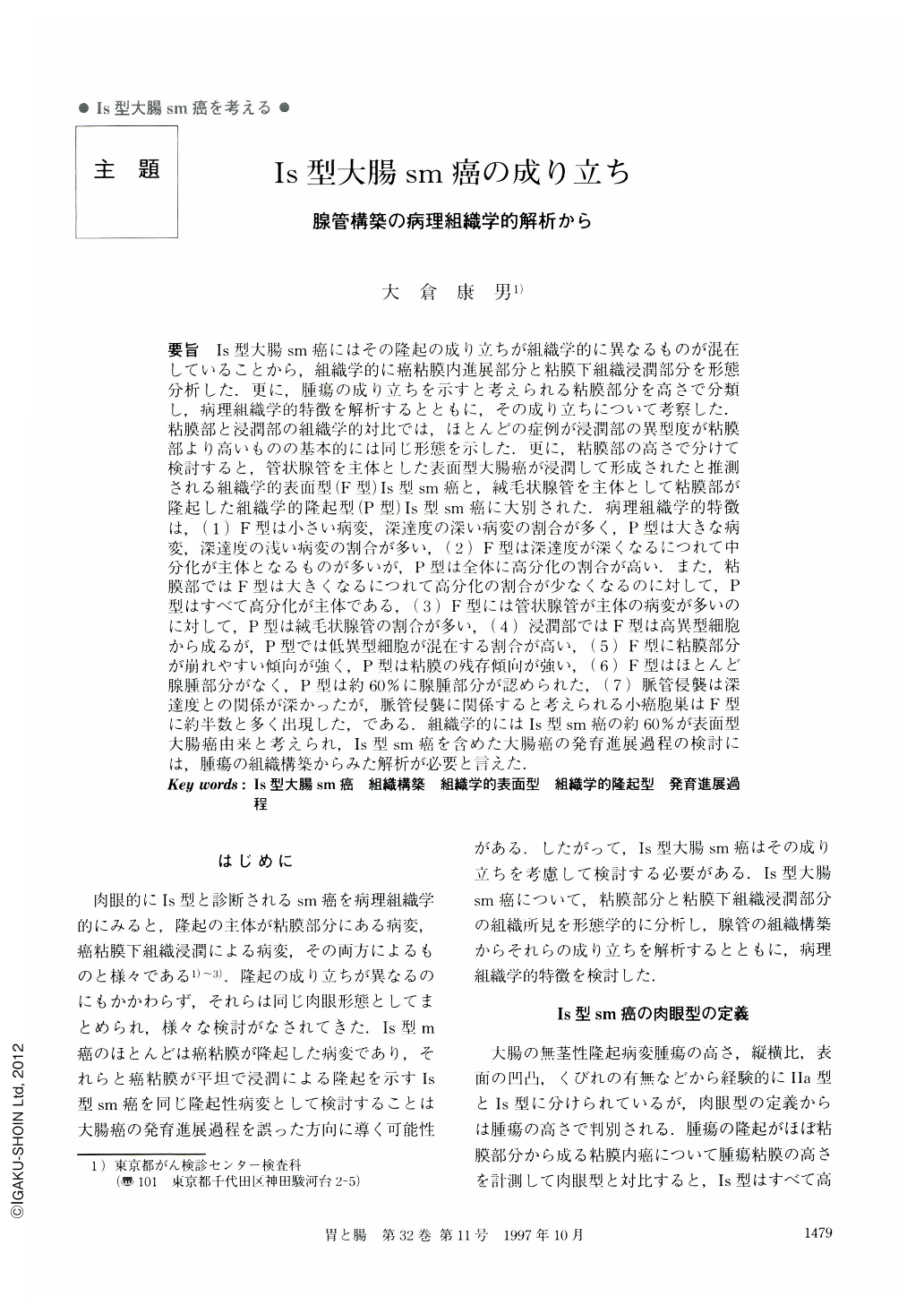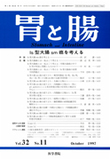Japanese
English
- 有料閲覧
- Abstract 文献概要
- 1ページ目 Look Inside
- サイト内被引用 Cited by
要旨 Is型大腸sm癌にはその隆起の成り立ちが組織学的に異なるものが混在していることから,組織学的に癌粘膜内進展部分と粘膜下組織浸潤部分を形態分析した.更に,腫瘍の成り立ちを示すと考えられる粘膜部分を高さで分類し,病理組織学的特徴を解析するとともに,その成り立ちについて考察した.粘膜部と浸潤部の組織学的対比では,ほとんどの症例が浸潤部の異型度が粘膜部より高いものの基本的には同じ形態を示した.更に,粘膜部の高さで分けて検討すると,管状腺管を主体とした表面型大腸癌が浸潤して形成されたと推測される組織学的表面型(F型)Is型sm癌と,絨毛状腺管を主体として粘膜部が隆起した組織学的隆起型(P型)Is型sm癌に大別された.病理組織学的特徴は,(1)F型は小さい病変,深達度の深い病変の割合が多く,P型は大きな病変,深達度の浅い病変の割合が多い,(2)F型は深達度が深くなるにつれて中分化が主体となるものが多いが,P型は全体に高分化の割合が高い.また,粘膜部ではF型は大きくなるにつれて高分化の割合が少なくなるのに対して,P型はすべて高分化が主体である,(3)F型には管状腺管が主体の病変が多いのに対して,P型は絨毛状腺管の割合が多い,(4)浸潤部ではF型は高異型細胞から成るが,P型では低異型細胞が混在する割合が高い,(5)F型に粘膜部分が崩れやすい傾向が強く,P型は粘膜の残存傾向が強い,(6)F型はほとんど腺腫部分がなく,P型は約60%に腺腫部分が認められた,(7)脈管侵襲は深達度との関係が深かったが,脈管侵襲に関係すると考えられる小癌胞巣はF型に約半数と多く出現した,である.組織学的にはIs型sm癌の約60%が表面型大腸癌由来と考えられ,Is型sm癌を含めた大腸癌の発育進展過程の検討には,腫瘍の組織構築からみた解析が必要と言えた.
The height of Is type of Submucosal invasive carcinoma involves two different elements; mucosal thickness and Submucosal invasion. Sixty-two cases of Is type of submucosal invasive carcinomas with mucosal spreading area were divided into three groups according to mucosal height. They were histopathologically flat type (F type) less than 2 mm in height, histopathologically protruded type (P type) more than 3 mm in height, and intermediate type (I type) with a height between 2 and 3 mm. Histologically, the glandular structure, differentiation, nuclear atypia, loss of mucosa by cancer invasion and accompaniment with adenomatous components were examined according to tumor size and invasive depth, and comparison was made between the mucosa and the submucosa. The histological figure of the submucosa had basically the same glandular structure as the mucosa, but was differentiated with higher grades of atypicality. Examined in these histopathological subgroups divided by mucosal height, histopathological differentiation between F type and P type was revealed as follows. 1) F type was a small but much more invasive cancer, and P type was large but much less invasive. 2) The categorization of P type was mostly well-differentiated adenocarcinoma, but that of F type was mixed with moderately differentiated adenocarcinoma modified by increase of size and invasion depth. 3) The glandular structure of F type was mainly tubular pattern, and its of P type was villotubular pattern. 4) Nucleori in the submucosa of F type had a high grade of atypia, but those of P type were mixed with a low grade of atypia. 5) F type showed a tendency to be accompanied with mucosal destruction brought on by cancer invasion. 6) Most of F type were without adenomatous components, but 60% of P type were accompanied by adenomatous components. 7) Minute cancer nests, which are associated with metastasis to the small vessels, were more prevalent among F type than P type. Histological features of I type were between F type and P type, but closer to F type. From these results different developmental courses for F type and P type can be presumed. F type arise from flat early carcinoma of tubular pattern and are made to protrude by invasion of the submucosa and the accompanying fibrosis. In contrast with this, P type develop according to the mucosal thickness of their villotubular pattern and then with submucosal invasion. In the Is type of submucosal invasive carcinomas, about 60% were F type, so it was supposed that most of the advanced carcinomas developed from flat type of carcinoma. The histopathological analysis of glandular structure is needed in the study of the development of colonic carcinoma.

Copyright © 1997, Igaku-Shoin Ltd. All rights reserved.


